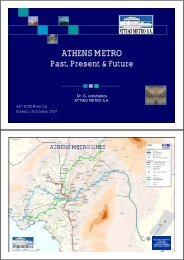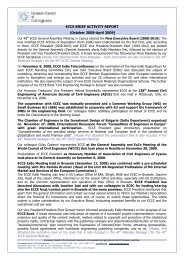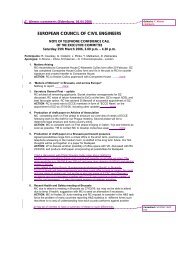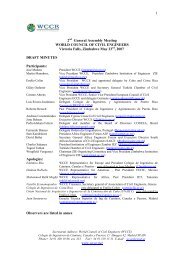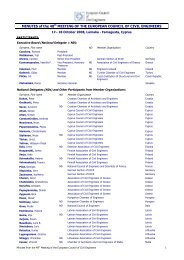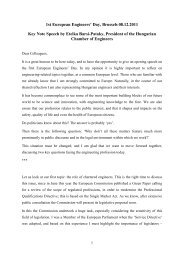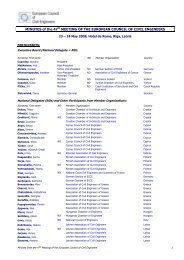A Closer Look at Prevailing Civil Engineering Practice - European ...
A Closer Look at Prevailing Civil Engineering Practice - European ...
A Closer Look at Prevailing Civil Engineering Practice - European ...
Create successful ePaper yourself
Turn your PDF publications into a flip-book with our unique Google optimized e-Paper software.
A <strong>Closer</strong> <strong>Look</strong> <strong>at</strong> <strong>Prevailing</strong> <strong>Civil</strong> <strong>Engineering</strong> <strong>Practice</strong>, Wh<strong>at</strong>, Why and How<br />
Vincent T. H. CHU<br />
(iii) Soil nail head and facing provides containment effect to limit the<br />
deform<strong>at</strong>ion near slope surface.<br />
Soil nail head serves to provide reaction in mobilizing tensile force in soil<br />
nail. Moreover, it provides confinement to soils in active zone behind soil<br />
nail head and avoids the occurrence of local failure between adjacent soil<br />
nails.<br />
4. Wh<strong>at</strong> is the purpose of install<strong>at</strong>ion of erosion control m<strong>at</strong> in<br />
slopes<br />
Steep slopes are prone to intermittent high velocity flows during rainstorm<br />
and this causes erosion <strong>at</strong> slope surface which prevents the growth of<br />
veget<strong>at</strong>ion.<br />
Erosion control m<strong>at</strong> is installed to control soil erosion and provide soil<br />
stability until veget<strong>at</strong>ion can be established. The principal function of<br />
erosion control m<strong>at</strong> is to prevent pre-veget<strong>at</strong>ed soil loss by stabilizing and<br />
protecting soils from rainfall and surface erosion. Moreover, it could provide<br />
a long-term artificial erosion control system which would increase the shear<br />
resistance of veget<strong>at</strong>ion and provide long-term, tenacious reinforcement of<br />
the root system.<br />
5. For Peck’s pressure envelope for braced excav<strong>at</strong>ion, should total<br />
weight or effective weight be used in rectangular and trapezoidal<br />
envelope<br />
The use of active and <strong>at</strong>-rest theory is not applicable in braced excav<strong>at</strong>ion.<br />
In essence, upper struts tend to be more heavily loaded while lower struts<br />
appear to be less loaded when compared with active pressure theory.<br />
Peck then measured the bracing loads which were converted back to soil<br />
pressures. For example, the pressure envelope for non-cohesive soils is<br />
0.65rHK a (r=soil density, H=height of excav<strong>at</strong>ion and K a =active pressure<br />
coefficient).<br />
Some engineers consider r as total soil weight without applying any w<strong>at</strong>er<br />
pressure. However, Peck has said “the earth pressures are essentially<br />
effective active pressures multiplied by a factor and redistributed as a<br />
rectangle or a trapezoid.” Hence, effective weight of soils should be used<br />
for r with w<strong>at</strong>er pressures added separ<strong>at</strong>ely.<br />
54






